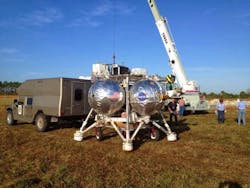Project Morpheus tests NASA automated, and even autonomous, landing and hazard-detection and -avoidance technology, as well as a novel spacecraft engine that runs on liquid oxygen and methane, considered “green” propellants.
Project Morpheus is intended to test and verify new capabilities that can be harnessed in future missions, enabling future human exploration of the solar system, interplanetary cargo delivery, and more.
Morpheus features include:
- An Aitech S950 CompactPCI board with a PowerPC 750 processor is used as the main computer.
- Up to 16 GB of data can be stored on board.
- Data buses include RS-422, RS-232, Ethernet and MIL-STD-1553.
- The avionics and power unit (APU) are cooled using liquid methane, any resulting vapor is then vented.
- Onboard cameras
- 8 lithium polymer batteries for electrical power
- GN&C sensor suite includes:
- Javad Global Positioning System (GPS) receiver
- International Space Station (ISS) version of Honeywell’s Space Integrated GPS/INS (SIGI)
- Litton LN-200 Inertial Measurement Unit (IMU)
- Acuity laser altimeter
- Goddard Space Flight Center’s (GSFC) Core Flight Software (CFS)
- TRN Laser altimetry and star trackers
- Ultra High Frequency (UHF) radios
NASA’s Morpheus Project, as described by NASA:
NASA's Morpheus Project has developed and tested a prototype planetary lander capable of vertical takeoff and landing. Designed to serve as a vertical testbed (VTB) for advanced spacecraft technologies, the vehicle provides a platform for bringing technologies from the laboratory into an integrated flight system at relatively low cost. This allows individual technologies to mature into capabilities that can be incorporated into human exploration missions.
NASA's strategic goal of extending human presence across the solar system requires an integrated architecture. Such architecture would include advanced, robust space vehicles for a variety of lunar, asteroid, and planetary missions; automated hazard detection and avoidance technologies to reduce risks to crews, landers, and precursor robotic payloads; and in situ resource utilization to support crews during extended stays on extraterrestrial surfaces and to provide for their safe return to Earth. NASA's Advanced Exploration Systems (AES) portfolio includes several fast-paced projects that are developing these necessary capabilities. Specifically, the Morpheus project and the Autonomous Landing and Hazard Avoidance Technology (ALHAT) project provide technological foundations for key components of the greater exploration architecture necessary to move humans beyond low Earth orbit (LEO).
NASA's Morpheus Project has developed and tested a prototype planetary lander capable of vertical takeoff and landing. Designed to serve as a vertical testbed (VTB) for advanced spacecraft technologies, the vehicle provides a platform for bringing technologies from the laboratory into an integrated flight system at relatively low cost. This allows individual technologies to mature into capabilities that can be incorporated into human exploration missions.
NASA's strategic goal of extending human presence across the solar system requires an integrated architecture. Such architecture would include advanced, robust space vehicles for a variety of lunar, asteroid, and planetary missions; automated hazard detection and avoidance technologies to reduce risks to crews, landers, and precursor robotic payloads; and in situ resource utilization to support crews during extended stays on extraterrestrial surfaces and to provide for their safe return to Earth. NASA’s Advanced Exploration Systems (AES) portfolio includes several fast-paced projects that are developing these necessary capabilities. Specifically, the Morpheus project and the Autonomous Landing and Hazard Avoidance Technology (ALHAT) project provide technological foundations for key components of the greater exploration architecture necessary to move humans beyond low Earth orbit (LEO).
The Morpheus project provides an autonomous, reusable, rocket-powered, terrestrial vertical take-off/vertical landing vehicle for testing integrated spacecraft and planetary lander technologies. The integrated vertical test bed (VTB) offers a platform to develop, mature, refine, and demonstrate advanced technologies that increase autonomy, reliability, safety, and reusability, and improve navigation and landing capabilities. Morpheus provides a way to help develop these technologies into systems that can be demonstrated and tested. Successfully implementing these capabilities will enable access to landing sites that were previously considered too hazardous to risk a robotic lander mission, much less a human mission.
Although Morpheus was designed and developed primarily at Johnson Space Center (JSC), other NASA centers, commercial entities, and academic institutions have supported its development and testing. For Morpheus and ALHAT, JSC has partnerships with Kennedy Space Center (KSC) for flight testing; Stennis Space Center (SSC) for engine testing; Marshall Space Flight Center (MSFC) for engine development and lander expertise; Goddard Space Flight Center (GSFC) for core flight software development, and Langley Research Center (LaRC), the Jet Propulsion Laboratory (JPL) for ALHAT development. Commercial partnerships with enterprises such as Jacobs Engineering, Armadillo Aerospace, Draper Labs, and others have augmented the development and operation of many aspects of the project.
The Morpheus vehicle is propelled by a liquid oxygen (LOX)/liquid methane propulsion system that can provide a specific impulse of up to 321 seconds during space flight, and these cryogenic propellants burn cleanly, are nontoxic, and can be stored easily in space. For future space missions, it may be possible to produce oxygen or methane in situ. Oxygen is already a necessary and compatible commodity for life support systems in spacecraft, and oxygen/methane systems are being studied for power generation. LOX and methane are also readily available and relatively safe and easy to handle, permitting frequent, low-cost ground testing. These attributes and potential capabilities make propulsion with LOX/methane an attractive technology.
ALHAT, the primary Morpheus payload, provides autonomous precision landing and hazard avoidance. When a vehicle lands autonomously, it must identify a safe landing site: one that is relatively flat and free of large boulders, rocks, and craters.

